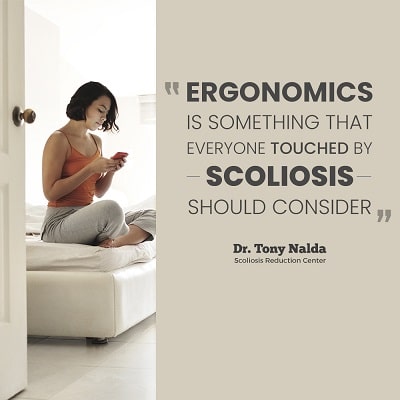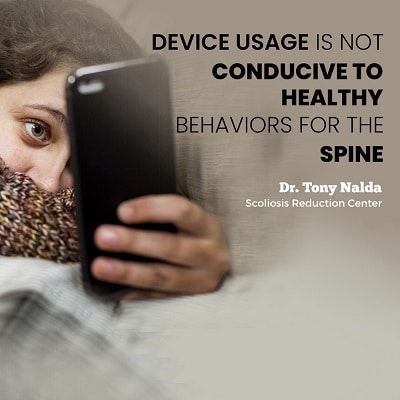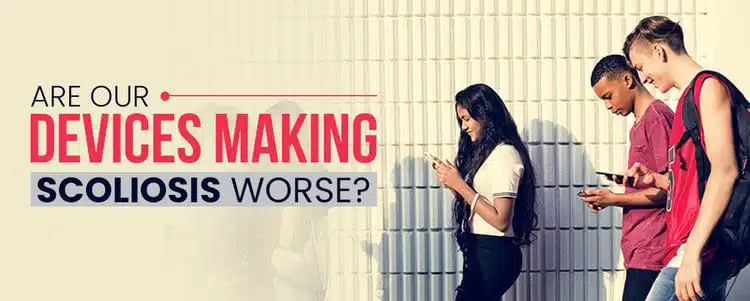Today’s technology allows us to do some amazing things. For example, I am writing this on my computer and sending it out to the Scoliosis Reduction Center® website via the internet. You may be thousands of miles away, but because of the technology involved, you have an opportunity to read this piece from the comfort of wherever you happen to be located. Amazing, isn’t it?
Technology also helps me evaluate, diagnose and treat scoliosis patients. Old-school technologies like X-rays are used in conjunction with the most up-to-date scanning and imaging tools to help determine the nature and progress of each patient’s condition. Thanks to technological innovations, I am able to treat more patients more effectively than would have been possible even just five or ten years ago.
We live in an amazing world of innovation, don’t we? But we also recognize that there is a dark side to technology. And it affects the lives of scoliosis patients in ways that should not be ignored.
Understanding Ergonomics

When I evaluate and treat my patients, I don’t just look at them physically. Scoliosis is a condition that affects numerous aspects of a patient’s life, which means that I have to consider their emotional and practical realities, as well.
Ergonomics is a term that rarely gets mentioned in traditional scoliosis treatment circles, but it is very important to the chiropractic-centered model of treatment. In case you are not familiar, ergonomics is defined as the study of people’s efficiency in their working environment. I would expand the definition to include all the ways in which people interact with the physical world on a day-to-day basis. Adolescents with scoliosis, for example, may not be dealing with jobs or conditions that are typical in normal working environments. But they go to school, play sports and interact with the rest of the world and its elements every day. Therefore, ergonomics is something that everyone touched by scoliosis should consider.
The way people interact with their devices also falls under the category of ergonomics. Perhaps it is no surprise to you, but data seems to indicate that smartphone and tablet usage has contributed to increases in reports of neck and back pain. As it turns out, the ways in which people use their devices have major impacts on physical health.
For people with scoliosis, ergonomic considerations are amplified because of the nature of their abnormally curved spines. They are more likely to experience pain and discomfort than those who do not have scoliosis. There are critical times in the lives of scoliosis patients, especially when they are in adolescence and still in the midst of developing, physically. Ergonomics are crucial to consider during these times because certain activities can make the condition worse.
To me, it is important to have a strong sense of awareness about ergonomics so patients can recognize behaviors that may impact the condition negatively. For young people with scoliosis in today’s world, many of those behaviors revolve around device usage.
Ergonomic Advice for Smarter Device Usage
The title of this piece asks if our devices are making scoliosis worse. I have to be honest — we do not really know if this is the case. We may never be able to answer this question conclusively. The fact is that most cases of scoliosis are idiopathic, and are likely caused by a host of different factors. There is simply no way to tell with certainty if device usage has an impact on scoliosis. Nevertheless, I think it is important to be aware of physical behaviors and habits so patients can engage in activities in ways that do not pose threats to their health or wellbeing.
We also do not know exactly how much working with patients ergonomically can improve the condition. We feel confident that it has a positive influence, but we do not know how strong that influence may be. Regardless, I believe strongly in encouraging behaviors that support healthy spines, decrease pain and enhance physical ability. When patients are smarter with their spines, the treatments provided under the chiropractic-centered model have a greater likelihood of succeeding.
Since devices like smartphones and tablets are so commonly used, especially among adolescents, a lot of media coverage has centered around “conditions” like “text neck” or “Blackberry thumbs.” These are not necessarily medically recognized conditions, but I think we all understand that regular usage of devices can have negative physical impacts. And although the long-term implications of device usage are not known at this time, it is better to err on the side of spine health and safety, particularly for those with scoliosis.
With that in mind, here are some tips that can help scoliosis patients avoid injury, complications or pain.
- Hold devices at chest level, not waist level — Much of the strain that comes from device usage has to do with where people hold their phones. Instead of constantly looking downward, users should raise their phones higher so they can keep their spines straighter and better aligned.
- Use hands to hold the phone — This may seem obvious until you realize how often people hold their phones between their shoulders and ears, in addition to other places! Cradling the phone in this fashion puts unnecessary strain and stress on the spine. These days there is no excuse for holding the phone improperly. Users can talk using speakerphone technology, or by utilizing any of the many hands-free devices that are available.
- Avoid typing long passages on smartphone screens — While it is possible to write an entire novel on a smartphone, our bodies do not react well to extensive typing on tiny phone screens. While phones are fine for texting and short email communications, longer passages of text should be written with proper keyboards. Users should focus on sitting with the proper posture, screen distance and foot and hand placement: Feet should be flat on the floor. The back should be supported by a chair. Shoulders should be relaxed. Wrists should be in a neutral position.
- Practice proper placement while reading on a tablet — It is becoming increasingly common for people to read books on their tablet devices. Sadly, people rarely consider posture, placement and positioning while doing so. The tablet should be placed in a manner that allows for comfortable body positioning. For those who like to read in bed, propping the tablet up on a pillow can be helpful.

- Take frequent, extended breaks from devices — This is probably the most important advice I can give on this subject. Device usage is not conducive to healthy behaviors for the spine, even if the user is hyper-vigilant about proper posture and positioning. Frequent breaks and time spent engaging with the world in other ways helps the body retain its flexibility and reduces strain.
Being Smarter with Smart Devices
If you or your child has scoliosis, you can benefit tremendously by paying attention to ergonomics, especially where devices like smartphones and tablets are concerned. Although we cannot prove if devices make scoliosis worse, we know that recovering from scoliosis is easier when the body feels healthy, strong and free from soreness. Therefore, being smart with smartphones and other devices is something I recommend strongly.





